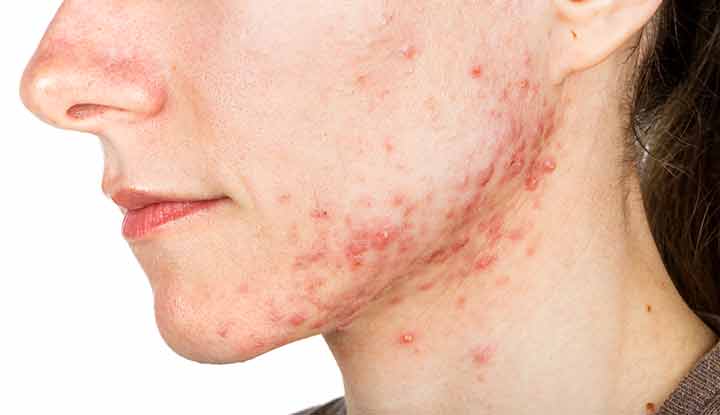People with cystic acne develop pus-filled acne cysts (pimples) deep under the skin. The acne cysts are often painful and can be large. A dermatologist should treat cystic acne to reduce the risk of scarring and infection. Antibiotics and prescription-strength topical (skin) creams can help clear up your skin.
Advertisement
Cleveland Clinic is a non-profit academic medical center. Advertising on our site helps support our mission. We do not endorse non-Cleveland Clinic products or services. Policy

Cystic acne is a type of inflammatory acne that causes painful, pus-filled pimples to form deep under the skin. Acne occurs when oil and dead skin cells clog skin pores.
Advertisement
Cleveland Clinic is a non-profit academic medical center. Advertising on our site helps support our mission. We do not endorse non-Cleveland Clinic products or services. Policy
With cystic acne, bacteria also gets into the pores, causing swelling or inflammation. Cystic acne is the most severe type of acne. Acne cysts are often painful and more likely to cause scarring.
Nodular acne and cystic acne are very similar. Both cause deep, painful bumps under the skin. And both can scar. Differences include:
Pores in the skin can clog with excess oil and dead skin cells, causing pimples. Bacteria can enter the skin pores and get trapped along with the oil and skin cells. The skin reaction causes swelling deep in the skin’s middle layer (the dermis). This infected, red, swollen lump is an acne cyst.
Cystic acne causes include:
Acne cysts resemble boils, a type of skin infection. An acne cyst may be:
A cystic acne breakout may cover a large area of skin. Cystic acne tends to appear on the face, which has a lot of oil glands. But you can also get acne cysts on your:
Advertisement
A dermatologist, a doctor who specializes in skin conditions, can examine your skin and make a cystic acne diagnosis.
Acne cysts can be difficult to treat. Because they can scar, you should seek help from a dermatologist instead of trying over-the-counter acne products. A dermatologist can teach you how to treat cystic acne.
It can take three months or more to clear up acne cysts. Treatment often involves taking oral antibiotics and applying prescription-strength topical gels or creams to the skin.
Cystic acne treatments include:
Other treatments for cystic acne include:
Opening up acne cysts — by popping or picking them — increases the risk of scarring and bacterial skin infections like cellulitis.
Some people develop pigment changes (light or dark) spots at the site of the acne cyst after the skin clears up. These spots may be pink, purple, red, black or brown. They eventually fade away, but it may take more than a year.
Most people with cystic acne can prevent severe breakouts or quickly treat acne cysts to prevent scarring. Often, but not always, cystic acne clears up or diminishes with age, as hormones settle down.
Severe or untreated cystic acne can affect how you feel about your appearance, making you anxious or depressed. If cystic acne bothers you, talk with your healthcare provider about getting help with fostering a positive self-image.
You can lower your risk of getting acne by taking these steps:
Advertisement
You should call your healthcare provider if you experience:
You may want to ask your healthcare provider:
It’s tempting to want to touch or pick at painful, swollen acne cysts. But cystic acne is more likely than other zits to scar or develop infections. A dermatologist can offer suggestions to prevent cystic acne. This doctor can also treat painful acne cysts, lowering the chances of scarring. Antibiotics and topical (skin) creams are effective cystic acne treatments.
Advertisement
Cleveland Clinic’s primary care providers offer lifelong medical care. From sinus infections and high blood pressure to preventive screening, we’re here for you.

Last reviewed on 08/25/2021.
Learn more about the Health Library and our editorial process.